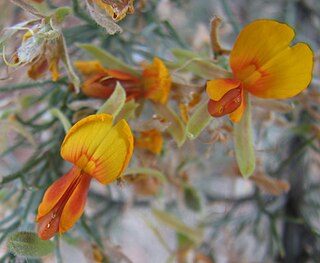
Jacksonia furcellata, commonly known as grey stinkwood, is a species of flowering plant in the family Fabaceae and is endemic to the south-west of Western Australia. It is a prostrate to low-lying, or weeping erect shrub with greyish-green branches, sharply-pointed side branches, its leaves reduced to scales leaves, yellowish-orange flowers, and woody, hairy pods.

Jacksonia sericea, commonly known as waldjumi, is a species of flowering plant in the family Fabaceae and is endemic to the south-west of Western Australia. It is a spreading to prostrate shrub with greyish-green branches, straight, sharply-pointed side branches, leaves reduced to scales, orange flowers with red markings, and woody, densely hairy pods.

Jacksonia lehmannii is a species of flowering plant in the family Fabaceae and is endemic to the south-west of Western Australia. It is an erect to prostrate or spreading, spindly shrub with greyish-green branches, sharply-pointed side branches, its leaves reduced to scales leaves, yellowish-orange flowers with orange-red markings, and woody, hairy pods.

Jacksonia acicularis is a species of flowering plant in the family Fabaceae and is endemic to the west of Western Australia. It is an erect, spindly shrub with very sharply-pointed short side branches, leaves reduced to scales, orange flowers with red markings, and densely hairy pods.

Jacksonia angulata is a species of flowering plant in the family Fabaceae and is endemic to the south-west of Western Australia. It is a tufted, spreading to prostrate shrub often with zig-zagged branches, sharply-pointed side branches or phylloclades, leaves reduced to broadly egg-shaped scales, yellow-orange to orange flowers with a red "eye", and woody, densely hairy pods.

Jacksonia arenicola is a species of flowering plant in the family Fabaceae and is endemic to the south-west of Western Australia. It is an erect, broom-like shrub with densely hairy, sharply-pointed phylloclades, yellow-orange flowers with red markings, and woody pods that are hairy at first, later glabrous.
Jacksonia arida is a species of flowering plant in the family Fabaceae and is endemic to Western Australia. It is an erect or prostrate shrub with tangled branches, sharply-pointed branchlets, yellow-orange to orange flowers, and woody pods.

Jacksonia calcicola is a species of flowering plant in the family Fabaceae and is endemic to the south west of Western Australia. It is a prostrate spreading or erect, prickly shrub with short, curved backwards and sharply pointed end branches, yellow-orange flowers with red markings, and woody, hairy pods.
Jacksonia calycina is a species of flowering plant in the family Fabaceae and is endemic to the south west of Western Australia. It is an erect or straggling shrub with sharply pointed end branches, yellow-orange flowers with red and yellow markings, and woody, hairy pods.

Jacksonia capitata is a species of flowering plant in the family Fabaceae and is endemic to the south of Western Australia. It is a spindly, low-lying to erect ascending shrub with curly, greyish green, cylindrical branches, the leaves reduced scales, and yellow-orange and red flowers in clusters at the ends of the shoots.

Jacksonia debilis is a species of flowering plant in the family Fabaceae and is endemic to the south west of Western Australia. It is a spreading to prostrate shrub with curved phylloclades, yellow-orange flowers with red markings, and woody, hairy pods.
Jacksonia epiphyllum is a species of flowering plant in the family Fabaceae and is endemic to the south of Western Australia. It is an erect or straggling shrub, the end branches egg-shaped or elliptic phylloclades, the leaves reduced to scale leaves, the flowers yellow-orange with red markings, and woody, densely-hairy pods.
Jacksonia eremodendron is a species of flowering plant in the family Fabaceae and is endemic to the south-west of Western Australia. It is a straggling shrub to small tree, the end branches egg-shaped, elliptic or oblong phylloclades with sharply-pointed teeth on the edges, the flowers yellow-orange with red markings and attached to teeth on phylloclades, and woody, densely-hairy pods.
Jacksonia foliosa is a species of flowering plant in the family Fabaceae and is endemic to the south west of Western Australia. It is a low-lying or erect shrub with sharply pointed end branches, yellow-orange flowers with red markings, and woody, hairy pods.

Jacksonia forrestii, commonly known as broom bush, is a species of flowering plant in the family Fabaceae and is endemic to the north-west of Australia. It is an erect, slender, weeping shrub or tree with sharply pointed phylloclades, yellow to yellow-orange flowers without markings, and woody, hairy pods.

Jacksonia gracillima is a species of flowering plant in the family Fabaceae and is endemic to the south-west of Western Australia. It is a low, spreading, compact shrub with greyish-green branches, yellow to yellow-orange or orange-red flowers with red markings, and woody, densely-hairy pods.
Jacksonia intricata is a species of flowering plant in the family Fabaceae and is endemic to the south of Western Australia. It is a domed, tangled shrub with copper-coloured branches when fresh, the end branches sharply-pointed, the leaves reduced to scales, yellow flowers with red markings, and woody, densely hairy pods.
Jacksonia jackson is a species of flowering plant in the family Fabaceae and is endemic to inland Western Australia. It is an erect, spindly, spreading shrub with dull green branches, the end branches sharply-pointed phylloclades, leaves reduced to egg-shaped scales, yellow-orange flowers with red markings, and woody, densely hairy pods.

Jacksonia nutans is a species of flowering plant in the family Fabaceae and is endemic to the south-west of Western Australia. It is an erect, prickly shrub with yellow to greyish-green branches, sharply-pointed branchlets, leaves reduced to triangular scales, orange flowers with red markings, and woody, densely hairy, round or elliptic pods.
Jacksonia pungens is a species of flowering plant in the family Fabaceae and is endemic to the south-west of Western Australia. It is an erect, rounded, domed shrub with greyish-green branches, scattered, sharply-pointed end branches, leaves reduced to dark brown, egg-shaped scales, orange-red flowers with red markings, and woody, densely hairy, elliptic pods.












